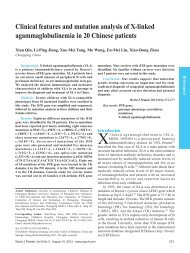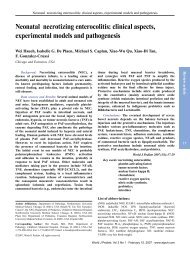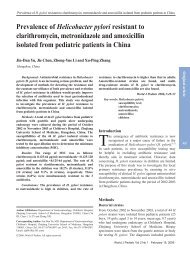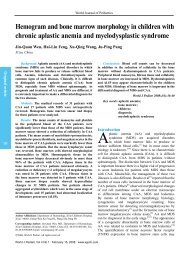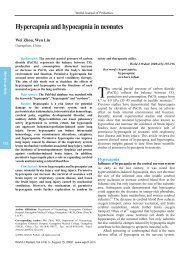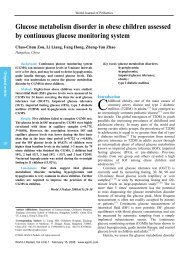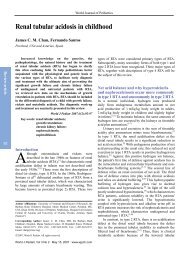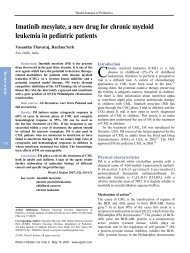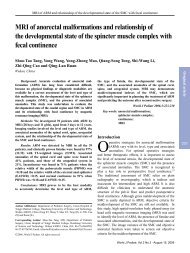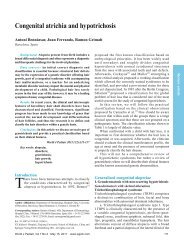Long-term effects of recurrent seizures on learning, behavior and ...
Long-term effects of recurrent seizures on learning, behavior and ...
Long-term effects of recurrent seizures on learning, behavior and ...
You also want an ePaper? Increase the reach of your titles
YUMPU automatically turns print PDFs into web optimized ePapers that Google loves.
<str<strong>on</strong>g>L<strong>on</strong>g</str<strong>on</strong>g>-<str<strong>on</strong>g>term</str<strong>on</strong>g> <str<strong>on</strong>g>effects</str<strong>on</strong>g> <str<strong>on</strong>g>of</str<strong>on</strong>g> <str<strong>on</strong>g>recurrent</str<strong>on</strong>g> <str<strong>on</strong>g>seizures</str<strong>on</strong>g> <strong>on</strong> <strong>learning</strong>, <strong>behavior</strong> <strong>and</strong> anxiety in rats<str<strong>on</strong>g>L<strong>on</strong>g</str<strong>on</strong>g>-<str<strong>on</strong>g>term</str<strong>on</strong>g> <str<strong>on</strong>g>effects</str<strong>on</strong>g> <str<strong>on</strong>g>of</str<strong>on</strong>g> <str<strong>on</strong>g>recurrent</str<strong>on</strong>g> <str<strong>on</strong>g>seizures</str<strong>on</strong>g> <strong>on</strong> <strong>learning</strong>,<strong>behavior</strong> <strong>and</strong> anxiety: an experimental study in ratsXiu-Yu Shi, Ji-Wen Wang, Ge-Fei Lei, Ruo-Peng SunJinan, ChinaBackground: Animal models have suggested that<str<strong>on</strong>g>seizures</str<strong>on</strong>g> in the developing brain cause less macroscopicstructural damage than <str<strong>on</strong>g>seizures</str<strong>on</strong>g> in adulthood butaccumulating evidence shows that <str<strong>on</strong>g>recurrent</str<strong>on</strong>g> <str<strong>on</strong>g>seizures</str<strong>on</strong>g> ininfants are associated with a high incidence <str<strong>on</strong>g>of</str<strong>on</strong>g> cognitivedeficits. In this study, we de<str<strong>on</strong>g>term</str<strong>on</strong>g>ined the <str<strong>on</strong>g>effects</str<strong>on</strong>g> <str<strong>on</strong>g>of</str<strong>on</strong>g><str<strong>on</strong>g>recurrent</str<strong>on</strong>g> ne<strong>on</strong>atal <str<strong>on</strong>g>seizures</str<strong>on</strong>g> <strong>on</strong> cognitive tasks using a set <str<strong>on</strong>g>of</str<strong>on</strong>g><strong>behavior</strong>al paradigms when the animals were in adulthood.Methods: Recurrent <str<strong>on</strong>g>seizures</str<strong>on</strong>g> were induced byinjecting rat pups with pilocarpine <strong>on</strong> postnatal day 2(P2), P4 <strong>and</strong> P7. In adulthood (P52-P56), spatial <strong>learning</strong>was examined by the Morris water maze; activity levelwas assessed by an open field test; <strong>and</strong> anxiety wasexamined by the elevated plus maze.Results: Compared with c<strong>on</strong>trols, rats with <str<strong>on</strong>g>recurrent</str<strong>on</strong>g><str<strong>on</strong>g>seizures</str<strong>on</strong>g> had deficient spatial <strong>learning</strong> <strong>and</strong> a greaterdegree <str<strong>on</strong>g>of</str<strong>on</strong>g> anxiety.C<strong>on</strong>clusi<strong>on</strong>s: Our findings indicate that <str<strong>on</strong>g>recurrent</str<strong>on</strong>g><str<strong>on</strong>g>seizures</str<strong>on</strong>g> during the ne<strong>on</strong>atal period result in life-l<strong>on</strong>gimpairment <str<strong>on</strong>g>of</str<strong>on</strong>g> certain cogniti<strong>on</strong>.Key words: epilepsy;development;pilocarpine;l<strong>on</strong>g-<str<strong>on</strong>g>term</str<strong>on</strong>g> <str<strong>on</strong>g>effects</str<strong>on</strong>g>;<strong>behavior</strong>al testing;water mazeIntroducti<strong>on</strong>Author Affiliati<strong>on</strong>s: Department <str<strong>on</strong>g>of</str<strong>on</strong>g> Pediatrics, Qilu Hospital, Sh<strong>and</strong><strong>on</strong>gUniversity, Jinan 250012, China (Shi XY, Wang JW, Lei GF, Sun RP)Corresp<strong>on</strong>ding Author: Ruo-Peng Sun, MD, Department <str<strong>on</strong>g>of</str<strong>on</strong>g> Pediatrics,Qilu Hospital, Sh<strong>and</strong><strong>on</strong>g University, No. 107 Wen Hua Xi Road, Jinan250012, China (Tel: 86-13854187216; Fax: 86-531-86927544; Email:sunruopeng1948@yahoo.com.cn)©2007, World J Pediatr. All rights reserved.World J Pediatr 2007;3(1):61-65Seizures occur more frequently in the ne<strong>on</strong>atalperiod than at any other time in life. In additi<strong>on</strong>to the increased risk for epilepsy in children,<str<strong>on</strong>g>seizures</str<strong>on</strong>g> during early development may be moredetrimental than those during adulthood. [1]Clinicalstudies suggest that <str<strong>on</strong>g>seizures</str<strong>on</strong>g> during development canproduce adverse l<strong>on</strong>g-<str<strong>on</strong>g>term</str<strong>on</strong>g> c<strong>on</strong>sequences. The meanIQ score in children with <str<strong>on</strong>g>seizures</str<strong>on</strong>g> is lower than that inthe normal populati<strong>on</strong>. [2,3] In additi<strong>on</strong> to problems withmemory <strong>and</strong> other cognitive processes, many patientswith epilepsy have also been diagnosed with affective<strong>and</strong> pers<strong>on</strong>ality disorders. However, there is <strong>on</strong>goingclinical discussi<strong>on</strong> <str<strong>on</strong>g>of</str<strong>on</strong>g> the possible damage induced byepileptic activity in the brains <str<strong>on</strong>g>of</str<strong>on</strong>g> infants <strong>and</strong> children. [4,5]Otherwise, the <str<strong>on</strong>g>effects</str<strong>on</strong>g> <str<strong>on</strong>g>of</str<strong>on</strong>g> <str<strong>on</strong>g>recurrent</str<strong>on</strong>g> <str<strong>on</strong>g>seizures</str<strong>on</strong>g> in immatureanimals were also c<strong>on</strong>troversial. For example, Sarkisianet al [6]reported that immature rats were spared froml<strong>on</strong>g-<str<strong>on</strong>g>term</str<strong>on</strong>g> cognitive <strong>and</strong> pathologic sequelae afterrepeated doses <str<strong>on</strong>g>of</str<strong>on</strong>g> kainate-induced status epileptics (SE).But other experiments [7-9] dem<strong>on</strong>strated that electricallyor chemically (e.g., kainic acid, pilocarpine, lithiumpilocarpine)induced <str<strong>on</strong>g>seizures</str<strong>on</strong>g> in rat pups resulted insignificant cognitive deficits <strong>and</strong> pathologic changes. Inthose experiments, the most comm<strong>on</strong>ly tested functi<strong>on</strong>swere spatial memory <strong>and</strong> <strong>learning</strong> functi<strong>on</strong>s, [10,11]butthere have been few studies to date which examined the<str<strong>on</strong>g>effects</str<strong>on</strong>g> <str<strong>on</strong>g>of</str<strong>on</strong>g> <str<strong>on</strong>g>recurrent</str<strong>on</strong>g> <str<strong>on</strong>g>seizures</str<strong>on</strong>g> <strong>on</strong> emoti<strong>on</strong>ality in immaturerats. Therefore the aim <str<strong>on</strong>g>of</str<strong>on</strong>g> the present study was toinvestigate the <str<strong>on</strong>g>effects</str<strong>on</strong>g> <str<strong>on</strong>g>of</str<strong>on</strong>g> pilocarpine-induced <str<strong>on</strong>g>recurrent</str<strong>on</strong>g><str<strong>on</strong>g>seizures</str<strong>on</strong>g> <strong>on</strong> <strong>learning</strong>, <strong>behavior</strong> <strong>and</strong> anxiety in immaturerats over a l<strong>on</strong>g period in this follow-up study.MethodsAnimalsNe<strong>on</strong>atal Wistar rats were obtained from theExperimental Animal Center <str<strong>on</strong>g>of</str<strong>on</strong>g> Sh<strong>and</strong><strong>on</strong>g University.The birth date was designated as postnatal day 0 (P0).The animals had access to food <strong>and</strong> water ad libitum<strong>and</strong> were housed with their lit<str<strong>on</strong>g>term</str<strong>on</strong>g>ates till weaning <strong>on</strong>P21, when they were group-housed in plastic cages <strong>on</strong>a st<strong>and</strong>ard 12-hour light/dark cycle. Experimental orc<strong>on</strong>trol animals remained together with their motheruntil weaning.Original article61World J Pediatr, Vol 3 No 1 . February 15, 2007 . www.wjpch.com
World Journal <str<strong>on</strong>g>of</str<strong>on</strong>g> PediatricsOriginal article62Inducti<strong>on</strong> <str<strong>on</strong>g>of</str<strong>on</strong>g> seizurePilocarpine (Sigma, St, Louis, MO, USA) was dissolvedin distilled water at a c<strong>on</strong>centrati<strong>on</strong> <str<strong>on</strong>g>of</str<strong>on</strong>g> 100 mg/ml <strong>and</strong>administered intraperit<strong>on</strong>eally (i.p.) to experimentalne<strong>on</strong>atal rats <strong>on</strong> P2, P4 <strong>and</strong> P7 at a dosage <str<strong>on</strong>g>of</str<strong>on</strong>g> 350mg/kg. All animals received scopolamine (1 mg/kg,i.p.) 30 minutes before pilocarpine administrati<strong>on</strong>to limit peripheral cholinergic <str<strong>on</strong>g>effects</str<strong>on</strong>g>. The animalswere m<strong>on</strong>itored throughout seizure inducti<strong>on</strong>, <strong>and</strong>seizure severity was assessed according to the scale <str<strong>on</strong>g>of</str<strong>on</strong>g>Lado. [12] The <strong>behavior</strong>al seizure scale in rat pups wassummarized by Lado as follows: stage 0, <strong>behavior</strong>alarrest; stage 1, mouth cl<strong>on</strong>us; stage 2, head bobbing;stage 3, unilateral forelimb cl<strong>on</strong>us; stage 3.5, alternatingforelimb cl<strong>on</strong>us; stage 4, bilateral forelimb cl<strong>on</strong>us withrearing; stage 5, bilateral forelimb cl<strong>on</strong>us with rearing<strong>and</strong> falling over; stage 6, wild running <strong>and</strong> jumpingwith vocalizati<strong>on</strong>; <strong>and</strong> stage 7, t<strong>on</strong>us. If the animalsdid not show obvious signs <str<strong>on</strong>g>of</str<strong>on</strong>g> seizure 30 minutes afterpilocarpine administrati<strong>on</strong>, additi<strong>on</strong>al dosage <str<strong>on</strong>g>of</str<strong>on</strong>g> 10 mg/kg pilocarpine was given every 10 minutes until the<strong>on</strong>set <str<strong>on</strong>g>of</str<strong>on</strong>g> seizure. If the c<strong>on</strong>vulsi<strong>on</strong>s lasted more than 30minutes, chloral hydrate (400 mg/kg) was administeredto the rats to <str<strong>on</strong>g>term</str<strong>on</strong>g>inate <str<strong>on</strong>g>seizures</str<strong>on</strong>g>. C<strong>on</strong>trol rats weregiven an equal volume <str<strong>on</strong>g>of</str<strong>on</strong>g> saline.Experimental proceduresThirty rats [experimental (exp), n=18; c<strong>on</strong>trol (c<strong>on</strong>),n=12] were used in this study. Two rats <str<strong>on</strong>g>of</str<strong>on</strong>g> theexperimental group died after <str<strong>on</strong>g>recurrent</str<strong>on</strong>g> <str<strong>on</strong>g>seizures</str<strong>on</strong>g>, 12rats were chosen from the live experimental groupfor further study. N<strong>on</strong>e <str<strong>on</strong>g>of</str<strong>on</strong>g> the c<strong>on</strong>trol group died.Experimental <strong>and</strong> c<strong>on</strong>trol rats were stochasticallydivided into two groups: group I <strong>and</strong> group II, 12 ratsin each group (exp, n=6; c<strong>on</strong>, n=6). Group I was testedfor spatial memory by Morris water maze <strong>on</strong> P52.Group II was tested by the open-field test <strong>and</strong> elevatedplus maze since P52.Morris water mazeOn P52, rats <str<strong>on</strong>g>of</str<strong>on</strong>g> group I were tested with water mazefor 4 days. A stainless-steel circular swimming pool(117 cm in diameter, 50 cm high) was filled to a depth<str<strong>on</strong>g>of</str<strong>on</strong>g> 25 cm with water. Two hundred milliliters <str<strong>on</strong>g>of</str<strong>on</strong>g>evaporated milk was added to make the water opaque<strong>and</strong> prevent visualizati<strong>on</strong> <str<strong>on</strong>g>of</str<strong>on</strong>g> the platform. Four points<strong>on</strong> the rim <str<strong>on</strong>g>of</str<strong>on</strong>g> the pool were designated north (N), south(S), east (E), <strong>and</strong> west (W), thus dividing the poolinto four quadrants (NW, NE, SE, SW). An 8 × 8 cmplexiglass platform, <strong>on</strong>to which the rat could escape,was positi<strong>on</strong>ed in the center <str<strong>on</strong>g>of</str<strong>on</strong>g> <strong>on</strong>e <str<strong>on</strong>g>of</str<strong>on</strong>g> the quadrants,1 cm below the water surface. One day before the test,each rat was placed in the pool for 60 sec<strong>on</strong>ds withoutthe platform present; this free swim enabled the rat tobecome habituated to the training envir<strong>on</strong>ment. On day1 through 4, the rat was trained for 24 trials (6 trials perday) to locate <strong>and</strong> escape <strong>on</strong>to the submerged platform.For each rat, the quadrant in which the platform waslocated remained c<strong>on</strong>stant, but the point <str<strong>on</strong>g>of</str<strong>on</strong>g> immersi<strong>on</strong>into the pool varied between N, E, S, <strong>and</strong> W in a quasir<strong>and</strong>omorder for the 24 trials, so that the rat was notable to predict the platform locati<strong>on</strong> from the point atwhich it was placed into the pool. The latency fromimmersi<strong>on</strong> into the pool to escape <strong>on</strong>to the platformwas recorded for each trial. If the rat did not find theplatform in 120 sec<strong>on</strong>ds it was manually placed <strong>on</strong> theplatform for a 30-sec<strong>on</strong>d rest. On day 5, the platformwas removed. The rat was allowed 60 sec<strong>on</strong>ds <str<strong>on</strong>g>of</str<strong>on</strong>g> freeswimming. The time spent in the quadrant where theplatform was previously located was measured (probetrial), which was c<strong>on</strong>sidered to assess memory forplatform locati<strong>on</strong>.Open-field testOn P52, rats <str<strong>on</strong>g>of</str<strong>on</strong>g> group II were tested in the openfieldtest. The floor <str<strong>on</strong>g>of</str<strong>on</strong>g> a square plastic board (50 × 50cm) with plastic sides (30 cm high) was divided into16 squares. The rats were individually placed in <strong>on</strong>ecorner <str<strong>on</strong>g>of</str<strong>on</strong>g> the open field <strong>and</strong> allowed to explore thearea freely. The activity level was expressed as thetotal number <str<strong>on</strong>g>of</str<strong>on</strong>g> squares crossed, whereas exploratoryactivity was expressed as the total number <str<strong>on</strong>g>of</str<strong>on</strong>g> rearingsduring a 5-minute testing period. The open-fieldapparatus was cleaned using alcohol before the nextanimal is introduced, to preclude the possible cuing<str<strong>on</strong>g>effects</str<strong>on</strong>g> <str<strong>on</strong>g>of</str<strong>on</strong>g> odors left by previous subjects. [13]Elevated plus mazeAfter the open-field test, rats <str<strong>on</strong>g>of</str<strong>on</strong>g> group II were testedin the elevated plus maze. The elevated plus-mazeapparatus was made <str<strong>on</strong>g>of</str<strong>on</strong>g> wood-block <strong>and</strong> c<strong>on</strong>sisted<str<strong>on</strong>g>of</str<strong>on</strong>g> four arms (39.5 cm l<strong>on</strong>g × 10 cm wide) fixed to acentral platform (10 cm × 10 cm): two had 12 cm highwalls (closed-arms) <strong>and</strong> two had no border in place<str<strong>on</strong>g>of</str<strong>on</strong>g> the walls (open-arms). The maze was elevated to aheight <str<strong>on</strong>g>of</str<strong>on</strong>g> 40 cm. The rat was brought individually tothe testing room 1 hour before the test was started. Fortesting, the rat was placed in the center <str<strong>on</strong>g>of</str<strong>on</strong>g> the maze, itshead facing an open-arm (the same for all mice) <strong>and</strong>its <strong>behavior</strong> was recorded by a group <str<strong>on</strong>g>of</str<strong>on</strong>g> experimenters,unaware <str<strong>on</strong>g>of</str<strong>on</strong>g> the treatments, for a period <str<strong>on</strong>g>of</str<strong>on</strong>g> 5 minutes.The primary measurements were the number <str<strong>on</strong>g>of</str<strong>on</strong>g> entries<strong>and</strong> the time spent in each arm. For the evaluati<strong>on</strong> <str<strong>on</strong>g>of</str<strong>on</strong>g>anxiety related animal <strong>behavior</strong>, the percentage <str<strong>on</strong>g>of</str<strong>on</strong>g>World J Pediatr, Vol 3 No 1 . February 15, 2007 . www.wjpch.com
<str<strong>on</strong>g>L<strong>on</strong>g</str<strong>on</strong>g>-<str<strong>on</strong>g>term</str<strong>on</strong>g> <str<strong>on</strong>g>effects</str<strong>on</strong>g> <str<strong>on</strong>g>of</str<strong>on</strong>g> <str<strong>on</strong>g>recurrent</str<strong>on</strong>g> <str<strong>on</strong>g>seizures</str<strong>on</strong>g> <strong>on</strong> <strong>learning</strong>, <strong>behavior</strong> <strong>and</strong> anxiety in ratstime spent <strong>on</strong> open/total arms <strong>and</strong> the percentage <str<strong>on</strong>g>of</str<strong>on</strong>g>open/total arm entries [open/(close + open) × 100] weremeasured as c<strong>on</strong>venti<strong>on</strong>al anxiety indices.Statistical analysisAll results were shown as mean±SEM. Differencesbetween means <str<strong>on</strong>g>of</str<strong>on</strong>g> the two groups were compared usingStudent's t test or the Mann-Whitney u test, depending<strong>on</strong> whether the data were normally distributed. SPSSfor Windows 11.5 s<str<strong>on</strong>g>of</str<strong>on</strong>g>tware was used for statisticalanalysis. In all cases, significance level was set atP
World Journal <str<strong>on</strong>g>of</str<strong>on</strong>g> PediatricsOriginal article64time swimming in the target quadrant than c<strong>on</strong>trols,suggesting that the experimental group had poorermemory <str<strong>on</strong>g>of</str<strong>on</strong>g> platform locati<strong>on</strong>. Although several factorsmay account for spatial <strong>learning</strong> deficits, a likelyexplanati<strong>on</strong> may be the mossy fiber sprouting. Thereare now c<strong>on</strong>siderable indirect evidence that these newneurites establish functi<strong>on</strong>al synaptic c<strong>on</strong>necti<strong>on</strong>s [18,19]<strong>and</strong> the degree <str<strong>on</strong>g>of</str<strong>on</strong>g> stratum pyramidale mossy fiberprojecti<strong>on</strong> correlates with <strong>learning</strong>. Lipp et al [20]showed that the magnitude <str<strong>on</strong>g>of</str<strong>on</strong>g> the stratum pyramidaleprojecti<strong>on</strong>s <str<strong>on</strong>g>of</str<strong>on</strong>g> mossy fibers correlated with the number<str<strong>on</strong>g>of</str<strong>on</strong>g> trials to criteri<strong>on</strong> in two-way avoidance <strong>learning</strong>with animals having more CA3 mossy fiber <str<strong>on</strong>g>term</str<strong>on</strong>g>inalsdoing less well than animals with fewer <str<strong>on</strong>g>term</str<strong>on</strong>g>inals.Crusio et al [21] found that the size <str<strong>on</strong>g>of</str<strong>on</strong>g> the hippocampalstratum pyramidale <strong>and</strong> infrapyramidal mossy fiber<str<strong>on</strong>g>term</str<strong>on</strong>g>inal field correlated inversely with the errornumber in a radial maze test. This study appears toprovide a structural substrate for augmentati<strong>on</strong> <str<strong>on</strong>g>of</str<strong>on</strong>g>synaptic activity that is worthy <str<strong>on</strong>g>of</str<strong>on</strong>g> further study.Furthermore, we used an open-field test toevaluate <strong>behavior</strong>al changes <str<strong>on</strong>g>of</str<strong>on</strong>g> rats. In open-fieldtest, no difference was seen in locomotor activityor exploratory activity between the c<strong>on</strong>trol <strong>and</strong>experimental rats. The case is not the same in adultrats; it has been dem<strong>on</strong>strated that hippocampalneur<strong>on</strong>al loss <strong>and</strong> open-field motor activity decreasedafter pentylenetetrazole kindling in mature rats overl<strong>on</strong>g periods. [22] But in genetically epilepsy-pr<strong>on</strong>e rats,frequent <strong>and</strong> brief <str<strong>on</strong>g>seizures</str<strong>on</strong>g> caused less motor activityin the open-field test. [23] All these studies have shownthat <strong>behavior</strong>al changes are related to the age <str<strong>on</strong>g>of</str<strong>on</strong>g> rats<strong>and</strong> type <str<strong>on</strong>g>of</str<strong>on</strong>g> seizure.We subjected all rats to the elevated plus maze toevaluate emoti<strong>on</strong>al memory <strong>and</strong> <strong>learning</strong> performance.Indeed, the elevated plus-maze is <strong>on</strong>e <str<strong>on</strong>g>of</str<strong>on</strong>g> the mostpopular models currently used in the study <str<strong>on</strong>g>of</str<strong>on</strong>g> animalanxiety. [24]In this test, the rats that experienced<str<strong>on</strong>g>recurrent</str<strong>on</strong>g> <str<strong>on</strong>g>seizures</str<strong>on</strong>g> at these early ages exhibitedheightened levels <str<strong>on</strong>g>of</str<strong>on</strong>g> anxiety as adults, again correlatingwith abnormal hippocampal/limbic system functi<strong>on</strong>.These findings corresp<strong>on</strong>d to the clinical report thatmany patients with epilepsy have also been diagnosedwith affective <strong>and</strong> pers<strong>on</strong>ality disorders. [25]We havedescribed that there was no difference in open-fieldtest, therefore the difference in anxiety scores betweenc<strong>on</strong>trol <strong>and</strong> experimental rats was not due to analterati<strong>on</strong> <str<strong>on</strong>g>of</str<strong>on</strong>g> locomotor or exploratory activity <strong>and</strong> maytherefore be a c<strong>on</strong>sequence associated with the seizurehistory. But how <str<strong>on</strong>g>seizures</str<strong>on</strong>g> result in anxiety-related<strong>behavior</strong> changes remains unclear. It is generallyaccepted that antenatal <strong>and</strong>/or early postnatal stressadversely affects human development, increasing thesusceptibility to diseases later in life, [26]as well asaltering <strong>behavior</strong>al <strong>and</strong> cognitive development. [27] These<str<strong>on</strong>g>effects</str<strong>on</strong>g> have been linked to persistent alterati<strong>on</strong>s in thehorm<strong>on</strong>al <strong>and</strong> metabolic resp<strong>on</strong>ses to stress associatedwith changes in the regulati<strong>on</strong> <str<strong>on</strong>g>of</str<strong>on</strong>g> the hypothalamicpituitary-adrenal(HPA) axis. Ne<strong>on</strong>atal rats experienced<str<strong>on</strong>g>recurrent</str<strong>on</strong>g> <str<strong>on</strong>g>seizures</str<strong>on</strong>g> in this study. Every seizure can beseen as a stress event, for previous study [28] has provedthat plasma glucocorticosteroid level sustained increasefollowing perinatal <str<strong>on</strong>g>recurrent</str<strong>on</strong>g> <str<strong>on</strong>g>seizures</str<strong>on</strong>g>. A large body<str<strong>on</strong>g>of</str<strong>on</strong>g> literature suggests that excess corticoster<strong>on</strong>e isdetrimental to hippocampal functi<strong>on</strong>s. [29,30] Recently, ithas been c<strong>on</strong>firmed that high levels <str<strong>on</strong>g>of</str<strong>on</strong>g> glucocorticoid(CORT) are thought to regulate all stages <str<strong>on</strong>g>of</str<strong>on</strong>g>neurogenesis. [31]New neur<strong>on</strong>s in the hippocampusare resp<strong>on</strong>sible for the formati<strong>on</strong> <str<strong>on</strong>g>of</str<strong>on</strong>g> new memory, [32]the detrimental effect <str<strong>on</strong>g>of</str<strong>on</strong>g> CORT <strong>on</strong> neurogenesis mayaccount for the <strong>behavior</strong>al deficits which were observedin this study. Furthermore, many researchers [33,34]observed that raised levels <str<strong>on</strong>g>of</str<strong>on</strong>g> CORT can induce atrophy<str<strong>on</strong>g>of</str<strong>on</strong>g> the apical dendrites <str<strong>on</strong>g>of</str<strong>on</strong>g> hippocampal CA3 pyramidalneur<strong>on</strong>s that appeared to retract their dendrites, whichmight have an impact <strong>on</strong> the total number <str<strong>on</strong>g>of</str<strong>on</strong>g> dendriticsynapses. However, synapses also play an importantrole in hippocampus-dependent <strong>learning</strong> <strong>and</strong> memory,so the impairment <str<strong>on</strong>g>of</str<strong>on</strong>g> synapses induced by raised levels<str<strong>on</strong>g>of</str<strong>on</strong>g> CORT may be another cause <str<strong>on</strong>g>of</str<strong>on</strong>g> <strong>behavior</strong>al deficits.In c<strong>on</strong>clusi<strong>on</strong>, <strong>on</strong> multiple measures <str<strong>on</strong>g>of</str<strong>on</strong>g> hippocampusbasedcognitive functi<strong>on</strong>s, the rats that experienced<str<strong>on</strong>g>recurrent</str<strong>on</strong>g> <str<strong>on</strong>g>seizures</str<strong>on</strong>g> during early development hadpersistent deficits: in water maze acquisiti<strong>on</strong> <strong>learning</strong><strong>and</strong> spatial memory as adults; <strong>and</strong> increased anxietyin elevated plus maze. These results suggest that<str<strong>on</strong>g>seizures</str<strong>on</strong>g> disrupt some aspect <str<strong>on</strong>g>of</str<strong>on</strong>g> hippocampal functi<strong>on</strong>during the early, vulnerable "critical period" <str<strong>on</strong>g>of</str<strong>on</strong>g> braindevelopment, with deficits observable l<strong>on</strong>g afterward.These observati<strong>on</strong>s may have clinical implicati<strong>on</strong>sfor cognitive <strong>and</strong> memory dysfuncti<strong>on</strong> associatedwith epilepsy during development. Therefore, furtherinvestigati<strong>on</strong> will involve gathering more informati<strong>on</strong>about clinical experiment <strong>and</strong> how to diminish theadverse <str<strong>on</strong>g>effects</str<strong>on</strong>g> <str<strong>on</strong>g>of</str<strong>on</strong>g> early perinatal <str<strong>on</strong>g>seizures</str<strong>on</strong>g> <strong>on</strong> <strong>learning</strong>,memory <strong>and</strong> anxiety.Funding: This study was supported by a grant from Science <strong>and</strong>Technology Bureau <str<strong>on</strong>g>of</str<strong>on</strong>g> Sh<strong>and</strong><strong>on</strong>g Province (No. 2004BS02015).Ethical approval: Not needed.Competing interest: N<strong>on</strong>e declared.C<strong>on</strong>tributors: SXY wrote the first draft <str<strong>on</strong>g>of</str<strong>on</strong>g> this paper. All authorsc<strong>on</strong>tributed to the intellectual c<strong>on</strong>tent <strong>and</strong> approved the final versi<strong>on</strong>.AcknowledgementsThe authors wish to thank Liu Chunxi, Liu Ping for theirWorld J Pediatr, Vol 3 No 1 . February 15, 2007 . www.wjpch.com
<str<strong>on</strong>g>L<strong>on</strong>g</str<strong>on</strong>g>-<str<strong>on</strong>g>term</str<strong>on</strong>g> <str<strong>on</strong>g>effects</str<strong>on</strong>g> <str<strong>on</strong>g>of</str<strong>on</strong>g> <str<strong>on</strong>g>recurrent</str<strong>on</strong>g> <str<strong>on</strong>g>seizures</str<strong>on</strong>g> <strong>on</strong> <strong>learning</strong>, <strong>behavior</strong> <strong>and</strong> anxiety in ratstechnical assistance with data collecti<strong>on</strong> <strong>and</strong> care <str<strong>on</strong>g>of</str<strong>on</strong>g> the animalsduring the study as well as Wang Yanling for editorial assistance.References1 Painter MJ, Bergman I, Crumrine P. Ne<strong>on</strong>atal <str<strong>on</strong>g>seizures</str<strong>on</strong>g>.Pediatr Clin North Am 1986;33:91-109.2 Farwell JR, Dodrill CB, Batzel LW. Neuropsychologicalabilities <str<strong>on</strong>g>of</str<strong>on</strong>g> children with epilepsy. Epilepsia 1985;26:395-400.3 Huttenlocher PR, Hapke RJ. A follow-up study <str<strong>on</strong>g>of</str<strong>on</strong>g> intractable<str<strong>on</strong>g>seizures</str<strong>on</strong>g> in childhood. Ann Neurol 1990;28:699-705.4 Holmes GL. Epilepsy in the developing brain: less<strong>on</strong>s fromthe laboratory <strong>and</strong> clinic. Epilepsia 1997;38:12-30.5 Suchomelova L, Kubova H, Haugvicova R, Druga R, MaresP. Are acute changes after status epilepticus in immature ratspersistent? Physiol Res 2002;51:185-192.6 Sarkisian MR, T<strong>and</strong><strong>on</strong> P, Liu Z, Yang Y, Hori A, Holmes GL,et al. Multiple kainic acid <str<strong>on</strong>g>seizures</str<strong>on</strong>g> in the immature <strong>and</strong> adultbrain: ictal manifestati<strong>on</strong>s <strong>and</strong> l<strong>on</strong>g-<str<strong>on</strong>g>term</str<strong>on</strong>g> <str<strong>on</strong>g>effects</str<strong>on</strong>g> <strong>on</strong> <strong>learning</strong><strong>and</strong> memory. Epilepsia 1997;38:1157-1166.7 Holmes GL, Gairsa JL, Chevassus-Au-Louis N, Ben-Ari Y.C<strong>on</strong>sequences <str<strong>on</strong>g>of</str<strong>on</strong>g> ne<strong>on</strong>atal <str<strong>on</strong>g>seizures</str<strong>on</strong>g> in the rat: morphological<strong>and</strong> <strong>behavior</strong>al <str<strong>on</strong>g>effects</str<strong>on</strong>g>. Ann Neurol 1998;44:845-857.8 Majak K, Pitkanen A. Do <str<strong>on</strong>g>seizures</str<strong>on</strong>g> cause irreversible cognitivedamage? Evidence from animal studies. Epilepsy Behav2004;5:35-44.9 Sayin U, Sutula TP, Stafstrom CE. Seizures in the developingbrain cause adverse l<strong>on</strong>g-<str<strong>on</strong>g>term</str<strong>on</strong>g> <str<strong>on</strong>g>effects</str<strong>on</strong>g> <strong>on</strong> spatial <strong>learning</strong> <strong>and</strong>anxiety. Epilepsia 2004;45:1539-1548.10 Wu CL, Huang LT, Liou CW, Wang TJ, Tung YR, Hsu HY,et al. Lithium-pilocarpine-induced status epilepticus inimmature rats result in l<strong>on</strong>g-<str<strong>on</strong>g>term</str<strong>on</strong>g> deficits in spatial <strong>learning</strong><strong>and</strong> hippocampal cell loss. Neurosci Lett 2001;312:113-117.11 Rutten A, Van Albada M, Silveira DC, Cha BH, Liu X, HuYN, et al. Memory impairment following status epilepticus inimmature rats: time-course <strong>and</strong> envir<strong>on</strong>mental <str<strong>on</strong>g>effects</str<strong>on</strong>g>. Eur JNeurosci 2002;16:501-513.12 Lado FA, Sperber EF, Moshe SL. Antic<strong>on</strong>vulsant efficacy<str<strong>on</strong>g>of</str<strong>on</strong>g> gabapentin <strong>on</strong> kindling in the immature brain. Epilepsia2001;42:458-463.13 Harro J, Haidkind R, Harro M, Modiri AR, Gillberg PG,Pahkla R, et al. Chr<strong>on</strong>ic mild unpredictable stress afternoradrenergic denervati<strong>on</strong>: attenuati<strong>on</strong> <str<strong>on</strong>g>of</str<strong>on</strong>g> behavioural<strong>and</strong> biochemical <str<strong>on</strong>g>effects</str<strong>on</strong>g> <str<strong>on</strong>g>of</str<strong>on</strong>g> DSP-4 treatment. EurNeuropsychopharmacol 1999;10:5-16.14 Hirsch E, Baram TZ, Snead OC 3rd. Ontogenic study <str<strong>on</strong>g>of</str<strong>on</strong>g>lithium-pilocarpine-induced status epilepticus in rats. BrainRes 1992;583:120-126.15 Stafstrom CE, Thomps<strong>on</strong> JL, Holmes GL. Kainic acid<str<strong>on</strong>g>seizures</str<strong>on</strong>g> in the developing brain: status epilepticus <strong>and</strong>sp<strong>on</strong>taneous <str<strong>on</strong>g>recurrent</str<strong>on</strong>g> <str<strong>on</strong>g>seizures</str<strong>on</strong>g>. Brain Res Dev Brain Res1992;65:227-236.16 Thurber S, Mikati MA, Stafstrom CE, Jensen FE, HolmesGL. Quisqualic acid-induced <str<strong>on</strong>g>seizures</str<strong>on</strong>g> during development: a<strong>behavior</strong>al <strong>and</strong> EEG study. Epilepsia 1994;35:868-875.17 Kornblum HI, Sankar R, Shin DH, Wasterlain CG, Gall CM.Inducti<strong>on</strong> <str<strong>on</strong>g>of</str<strong>on</strong>g> brain derived neurotrophic factor mRNA by<str<strong>on</strong>g>seizures</str<strong>on</strong>g> in ne<strong>on</strong>atal <strong>and</strong> juvenile rat brain. Brain Res MolBrain Res 1997;44:219-228.18 Okazaki ME, Evens<strong>on</strong> DA, Nadler JV. Hippocampal mossyfiber sprouting <strong>and</strong> synapse formati<strong>on</strong> after status epilepticusin rats: visualizati<strong>on</strong> after retrograde transport <str<strong>on</strong>g>of</str<strong>on</strong>g> biocytin. JComp Neurol 1995;352:515-534.19 Wuarin JP, Dudek FE. Electrographic <str<strong>on</strong>g>seizures</str<strong>on</strong>g> <strong>and</strong> new<str<strong>on</strong>g>recurrent</str<strong>on</strong>g> excitatory circuits in the dentate gyrus <str<strong>on</strong>g>of</str<strong>on</strong>g>hippocampal slices from kainate-treated epileptic rats. JNeurosci 1996;16:4438-4448.20 Lipp HP, Schwegler H, Heimrich B, Driscoll P. Infrapyramidalmossy fibers <strong>and</strong> two-way avoidance <strong>learning</strong>: developmentalmodificati<strong>on</strong> <str<strong>on</strong>g>of</str<strong>on</strong>g> hippocampal circuitry <strong>and</strong> adult <strong>behavior</strong> <str<strong>on</strong>g>of</str<strong>on</strong>g>rats <strong>and</strong> mice. J Neurosci 1988;8:1905-1921.21 Crusio WE, Schwegler H, Lipp HP. Radial-maze performance<strong>and</strong> structural variati<strong>on</strong> <str<strong>on</strong>g>of</str<strong>on</strong>g> the hippocampus in mice:a correlati<strong>on</strong> with mossy fibre distributi<strong>on</strong>. Brain Res1987;425:182-185.22 Franke H, Kittner H. Morphological alterati<strong>on</strong>s <str<strong>on</strong>g>of</str<strong>on</strong>g> neur<strong>on</strong>s<strong>and</strong> astrocytes <strong>and</strong> changes in emoti<strong>on</strong>al <strong>behavior</strong> inpentylenetetrazol-kindled rats. Pharmacol Biochem Behav2001;70:291-303.23 Holmes GL, Thomps<strong>on</strong> JL, Marchi TA, Gabriel PS, HoganMA, Carl FG, et al. Effects <str<strong>on</strong>g>of</str<strong>on</strong>g> <str<strong>on</strong>g>seizures</str<strong>on</strong>g> <strong>on</strong> <strong>learning</strong>, memory,<strong>and</strong> <strong>behavior</strong> in the genetically epilepsy-pr<strong>on</strong>e rat. Ann Neurol1990;27:24-32.24 Bertoglio LJ, Carobrez AP. Prior maze experience required toalter midazolam <str<strong>on</strong>g>effects</str<strong>on</strong>g> in rats submitted to the elevated plusmaze.Pharmacol Biochem Behav 2002;72:449-455.25 Dodrill CB. Neuropsychological <str<strong>on</strong>g>effects</str<strong>on</strong>g> <str<strong>on</strong>g>of</str<strong>on</strong>g> <str<strong>on</strong>g>seizures</str<strong>on</strong>g>. EpilepsyBehav 2004;5(Suppl 1):S21-24.26 Barker DJ. Fetal programming <str<strong>on</strong>g>of</str<strong>on</strong>g> cor<strong>on</strong>ary heart disease.Trends Endocrinol Metab 2002;13:364-368.27 Charm<strong>and</strong>ari E, Kino T, Souvatzoglou E, Chrousos GP.Pediatric stress: horm<strong>on</strong>al mediators <strong>and</strong> human development.Horm Res 2003;59:161-179.28 Liu H, Kaur J, Dashtipour K, Kinyamu R, Ribak CE,Friedman LK. Suppressi<strong>on</strong> <str<strong>on</strong>g>of</str<strong>on</strong>g> hippocampal neurogenesis isassociated with developmental stage, number <str<strong>on</strong>g>of</str<strong>on</strong>g> perinatalseizure episodes, <strong>and</strong> glucocorticosteroid level. Exp Neurol2003;184:196-213.29 Coburn-Litvak PS, Pothakos K, Tata DA, McCloskey DP,Anders<strong>on</strong> BJ. Chr<strong>on</strong>ic administrati<strong>on</strong> <str<strong>on</strong>g>of</str<strong>on</strong>g> corticoster<strong>on</strong>eimpairs spatial reference memory before spatial workingmemory in rats. Neurobiol Learn Mem 2003;80:11-23.30 Woods<strong>on</strong> JC, Macintosh D, Fleshner M, Diam<strong>on</strong>d DM.Emoti<strong>on</strong>-induced amnesia in rats: working memoryspecificimpairment, corticoster<strong>on</strong>e-memory correlati<strong>on</strong>,<strong>and</strong> fear versus arousal <str<strong>on</strong>g>effects</str<strong>on</strong>g> <strong>on</strong> memory. Learn Mem2003;10:326-336.31 W<strong>on</strong>g EY, Herbert J. Raised circulating corticoster<strong>on</strong>einhibits neur<strong>on</strong>al differentiati<strong>on</strong> <str<strong>on</strong>g>of</str<strong>on</strong>g> progenitor cells in theadult hippocampus. Neuroscience 2006;137:83-92.32 Shors TJ, Miesegaes G, Beylin A, Zhao M, Rydel T, Gould E.Neurogenesis in the adult is involved in the formati<strong>on</strong> <str<strong>on</strong>g>of</str<strong>on</strong>g> tracememories. Nature 2001;410:372-376.33 Watanabe Y, Gould E, McEwen BS. Stress induces atrophy<str<strong>on</strong>g>of</str<strong>on</strong>g> apical dendrites <str<strong>on</strong>g>of</str<strong>on</strong>g> hippocampal CA3 pyramidal neur<strong>on</strong>s.Brain Res 1992;588:341-345.34 Magariños AM, McEwen BS. Stress-induced atrophy <str<strong>on</strong>g>of</str<strong>on</strong>g> apicaldendrites <str<strong>on</strong>g>of</str<strong>on</strong>g> hippocampal CA3c neur<strong>on</strong>s: comparis<strong>on</strong> <str<strong>on</strong>g>of</str<strong>on</strong>g>stressors. Neuroscience 1995;69:83-88.Received August 24, 2006Accepted after revisi<strong>on</strong> September 9, 2006Original article65World J Pediatr, Vol 3 No 1 . February 15, 2007 . www.wjpch.com



